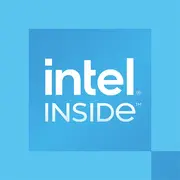Intel Processor N100

Intel Processor N100: Budget Energy Efficiency for Everyday Tasks
Overview of the Capabilities and Use Cases of the 2025 Processor
Architecture and Technology Process: Efficiency in a Compact Form Factor
The Intel N100 processor, released as part of the Alder Lake-N lineup, is designed for devices where low power consumption and compactness are key parameters. It is based on Intel's hybrid architecture 7 (10 nm Enhanced SuperFin) but, unlike flagship models, it uses only 4 energy-efficient Gracemont cores without performance P-cores. This helps maintain a TDP of 6 Watts, which is critical for passive cooling.
- Cores and Threads: 4 cores / 4 threads (Hyper-Threading is not supported).
- Clock Frequencies: Base — 1.8 GHz, maximum in turbo mode — 3.4 GHz.
- Graphics: Intel UHD Graphics (24 EU, frequency up to 750 MHz) — supports 4K video decoding at 60fps (H.265, VP9) but is not designed for 3D rendering.
Despite the absence of P-cores, the processor is optimized for background tasks: browser tabs, office applications, streaming video.
Power Consumption and TDP: Why Is 6 Watts an Advantage?
A TDP of 6 Watts makes the N100 one of the "coolest" processors on the market. This allows:
- Use of passive cooling (fanless), reducing noise and the thickness of the case.
- Placement of the chip in ultra-thin laptops and mini-PCs (e.g., Intel NUC format devices).
However, under prolonged loads (e.g., video rendering), throttling may occur due to the limited thermal package. For everyday tasks, this is not critical: the processor quickly completes peak operations and returns to the base frequency.
Performance: What Can the Intel N100 Do in Practice?
Office Work and Multimedia
- Browser: Simultaneous operation with 10-15 tabs in Chrome + Microsoft Teams — with no noticeable lag.
- Documents: LibreOffice, Google Docs, Excel with spreadsheets up to 10,000 rows — smooth scrolling.
- Video: Streaming 4K (YouTube, Netflix) and editing in DaVinci Resolve (1080p projects with minimal effects).
Gaming
- eSports: CS2 — 720p, low settings, 30-40 FPS; Dota 2 — similarly.
- Indie Games: Stardew Valley, Hollow Knight — 60 FPS without issues.
- Cloud Gaming: Services like Xbox Cloud Gaming — an optimal option for AAA projects.
Turbo Mode
A temporary boost to 3.4 GHz helps in scenarios like opening "heavy" websites or PDF files. However, under load for more than 2-3 minutes, the frequency drops to 2.5-2.8 GHz.
Use Cases: Who Is This Processor Suitable For?
- Students: Working with text, online courses, Zoom.
- Office Workers: Emails, spreadsheets, presentations.
- Media Center Users: Watching 4K content, streaming.
- Compact Device Owners: Mini-PCs for connecting to TVs, portable laptops for travel.
Not suitable for: 4K video editing, 3D modeling, modern AAA games.
Battery Life: How Does the N100 Extend Battery Life?
With a battery capacity of 40-50 Wh, laptops featuring the N100 demonstrate:
- Up to 12 hours of web surfing (brightness at 150 nits, Wi-Fi).
- Up to 8 hours of video (local 1080p).
Power Saving Technologies:
- Intel Speed Shift: Dynamic frequency adjustment to reduce lag.
- C6/C7 States: Deep sleep states for cores at idle.
- Adaptive Brightness: Integration with the laptop's light sensors.
Comparison with Competitors: Who Challenges the N100?
- AMD Athlon Silver 7220U (Zen 2): 2 cores / 2 threads, TDP 8-15 Watts. N100 outperforms in multitasking and energy efficiency.
- Apple M1 (in basic iPads): 2-3 times more powerful but more expensive ($599+ vs. $300-450 for N100 devices).
- Qualcomm Snapdragon 7c Gen 3 (ARM): Better battery life (up to 15 hours) but limited compatibility with x86 applications.
Conclusion: The N100 is optimal for budget Windows devices.
Pros and Cons of Intel N100
Strengths:
- Laptop prices starting from $300 (e.g., ASUS Vivobook Go 15).
- Passive cooling — zero noise.
- Support for modern codecs and Wi-Fi 6.
Weaknesses:
- No support for PCIe 4.0 (only PCIe 3.0 x9).
- Maximum 16 GB RAM (DDR4/LPDDR5).
- Weaker graphics compared to AMD Radeon 610M.
Laptop Purchase Recommendations
1. Device Type: Ultrabook (Acer Swift 1), convertible (Lenovo IdeaPad Flex 5i), mini-PC (Beelink U59).
2. Configuration Options:
- Required: 8 GB RAM, 256 GB SSD.
- Preferred: IPS display with 1080p resolution, USB-C with Power Delivery.
3. What to Avoid: HDDs, 4 GB RAM, TN displays.
Examples of 2025 Models:
- HP Pavilion x360 14 ($399): Touchscreen, 8 GB RAM, 128 GB SSD.
- Dell Inspiron 15 3525 ($349): 15.6" 1080p, Wi-Fi 6, 10 hours of battery life.
Final Conclusion: Who Should Choose the N100?
This processor is the ideal option for those seeking a cheap, quiet, and long-lasting laptop for basic tasks. It won't handle 4K video editing or 2025 games, but it will provide comfortable performance for document work, browsing, and media.
Key Benefits:
- Price under $500.
- Battery life up to 12 hours.
- Modern connectivity standards (USB-C, Wi-Fi 6).
If your needs don't exceed everyday tasks, the Intel N100 will be a reliable choice without overpaying.
Basic
CPU Specifications
Memory Specifications
GPU Specifications
Miscellaneous
Related CPU Comparisons
Share in social media
Or Link To Us
<a href="https://cputronic.com/cpu/intel-processor-n100" target="_blank">Intel Processor N100</a>
